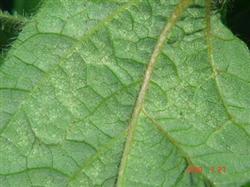Occurrence and Control of Soybean Red Spider

Red spider is the general name of red spider mite. It is a compound population of several spider mites and belongs to the family Tetranychidae. In Huachuan County, it occurs to varying degrees every year, but it belongs to the year of light occurrence. However, according to this year's survey, due to the recent high temperature and drought, the harm of red spiders to soybeans in Huachuan County has risen from secondary to major, and some villages and towns have also caused varying degrees of harm. Harmful characteristics: adult mites and nymph mites gather on the back of the leaves to form a net and suck sap. Yellow and white spots appeared on the front of soybean leaves at the initial stage of damage, and after 3-5 days, the spot area expanded, the spots became dense, and the leaves began to appear reddish-brown patches. With the aggravation of the damage, the leaves became rusty brown, like burning, and the leaves curled and finally fell off. Its morphological characteristics: the adult is a small red spider, the body is oval or pear-shaped, the body color changes greatly, generally orange-red or rust-red, with long capillaries on the back. The body is only a few millimeters long and wide. Eggs: spherical, yellowish white to orange. Young mites: 3 pairs of feet, round body, yellow-white, oval light green after feeding, dark green spots on both sides of the back of the body. Nymph mites: 4 pairs of foot, light green to light orange yellow, setae on the back, similar to adult mites in the later stage. Its living habits: more than ten generations a year in Heilongjiang Province, overwintering with female adults on the roots of weeds and soybean plant residues. The activity began at the end of May of the following year, first propagated on weeds, and then moved to soybean to harm, at first the spot occurred, then crawled or spun and spread through wind and rain, first harmed the lower leaves, and then spread upward, when the number of reproduction was too much, it often gathered at the leaf tip, rolled down, and drifted with the wind, spreading to other plants. The plots with more nitrogen fertilizer had heavy occurrence, and there was a habit of migration when the plants were dead and lack of food, and the damage peak was from July to August. The older the plant leaves are, the faster the reproduction rate of spider mites is. It is suitable to occur when the relative humidity is 35% ~ 55%, but it is not conducive to occurrence when the relative humidity is more than 70%. The high temperature and drought weather is beneficial to the occurrence. Chemical control technology: when red spider spot tablets occur, choose agents with good efficacy, long duration and no drug harm. 1. 1.8% Zongmike EC 3000 times liquid. 2. 73% Miaojing 3000 times solution. 3. 20% dicofol 1000-1500 times. 4, 20% mite EC 2000 times liquid. To sum up, the control effect can be achieved by choosing any kind of medicament. Biological agent avermectin and bionic pesticide 1.8% agricultural mite EC can also be used, and the effect of 2000 times liquid is excellent.
- Prev

The cause of empty chaff of soybean
1. The difference of breed. The occurrence of middle and late maturity varieties was more serious, while that of early and middle maturity varieties was lighter. two。 Drought and waterlogging during childbearing period are the key factors leading to high grain rate. The best rainfall at the flowering and pod stage of soybean is 180 mm. In soybean flower and pod period, waterlogging damage is more harmful than drought, especially waterlogging disaster, empty grain rate,.
- Next

Prevention and control of soybean top blight
Soybean top blight, also known as bud blight, is one of the soybean virus diseases that have a great impact on yield. Due to different periods of onset, the loss caused was 25% to 100%. Similar symptoms appeared on the foreign varieties introduced in Shandong Province in 1962, and then there were similar symptoms in Hebei, Beijing, Liaoning, Jilin, Heilongjiang and other places.
Related
- The first cup of black tea in spring, the flavor and history of tea gardens in Kenya, Africa
- The computer can not only choose potatoes, but also grow tea rice. AI will grow winter oolong tea champion.
- It is not only the inflated tea bitten by insects, but also engraved with the four seasons tea in Beipu.
- The Oriental Beauty Tea Festival in Zhuxian County takes the stage at the weekend to experience the plus-size feast of oil tea.
- & quot; Oriental Beauty Tea & Exploration of Emei in Hsinchu, the hometown of quot;
- The new variety of strawberry "Tainong 1" dessert is the first choice with mellow aroma. Crimson gorgeous
- History of Tea in Taiwan: from Wild Inner Mountain to Export Tea Garden
- Two types of Taiwan Oriental Beauty Black Tea won the British three-Star Award for Childhood Tea Xiang Zhang Jiaqi changed from pilot to champion tea maker.
- Banana species and varieties: the planting history of Taiwan Xianren banana and dwarf banana is long, is banana disease resistant?
- Coffee planting Technology: Qianjie Coffee from Seedling to harvesting

